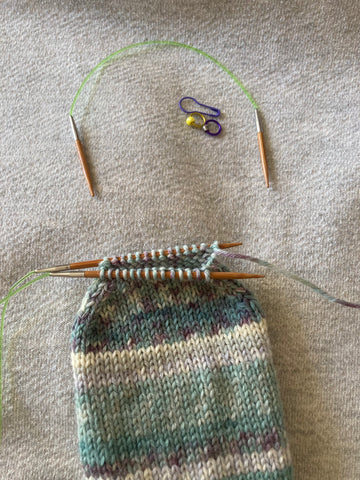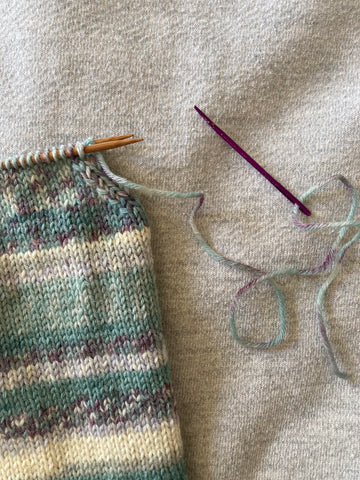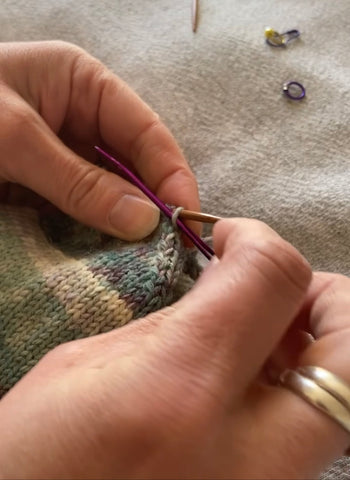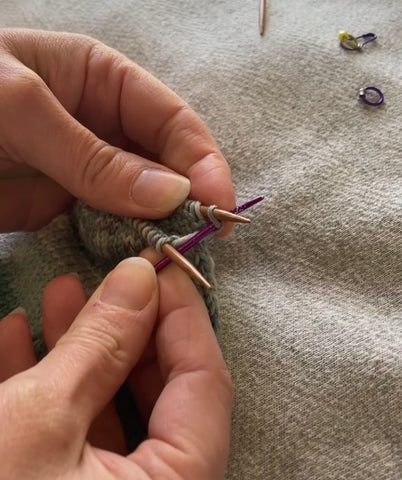How To....Kitchener Stitch (graft knitting)
It doesn't seem to matter how many times I graft a toe on a sock - I always, without fail, double check the instructions! It's become a ritual, a little confidence boost before I dive in to seal the deal and make the magic happen!
I thought it might be helpful to make a blog post with instructions, photos and videos so you can refer to it, if like me you need a bit of reassurance before you graft. If you'd like to read a bit of history relating to the "Kitchener stitch' scroll on down to the end!
(I'm using Regia 6 ply yarn here in Voss and Hiya Hiya circulars. and followed Winwick Mum Basic Boot sock pattern - have a look at our sock kits here)
Step 1

Find somewhere quiet where you won't be disturbed for 20 minutes or so!
Divide the remaining stitches equally on two needles (dpns/long circular/straight) as above.
Step 2.

Cut yarn leaving a good amount to graft and weave in after, then thread onto a tapestry needle.
Step 3 - refer to video also

Go into the first stitch on the front needle as if to purl - leave stitch on needle.

Then go into the stitch on the back needle as if to knit and leave on the needle.
**I did pick up a tip that said leaving this step out can stop the little ears (loops) either side of grafting. I sometimes do and then other times don't. Experiment!**
Step 4 - refer to video
Now it's easier to refer to video. You will be repeating the next four moves to the end. Two moves on the front needle - then two on the back. The video starts at the beginning with the preliminary steps also, you can watch on Instagram here or on YouTube here (with no text)
Go into the first stitch on the front needle as if to knit - and remove from the needle. Then go into the next stitch on the front needle as if to purl and leave on.
Go into the first stitch on the back needle as if to purl and remove from the needle. Then go into next stitch as if to knit and leave on.
Knit off, purl on.
Purl off, knit on.
It's not the catchiest of rhymes but you do get into a rhythm I promise. As I mentioned above - it's important that you're somewhere quiet with no interruptions - but if you have to stop midway, I'd get to the end of move 4 so you know where you are.
Repeat until there are 2 stitches remaining - then you will just go into front needle stitch as if to knit and remove and then to back needle as if to purl and remove - weave in and you've got a seamless finish!
A bit of grafting history! Why the name Kitchener stitch?
While I was typing 'Kitchener Stitch' for the little video - it got me thinking about where the name came from. It is said that the name came about because Horatio Herbert Kitchener (the guy in the poster pointing at YOU to recruit soldiers, who was Secretary of State during WW1, a General during the Boer War in South Africa and served in Egypt & Sudan) had requested knitted socks for soldiers to be grafted at the toe, as the bumpy seam was causing blisters and generally wasn't helping already damaged feet. I came across many blog posts and discussions around this. Some say he wrote an actual pattern with a 'grawfted' toe - but there isn't any evidence for this. Knitting historian Richard Rutt says that grafting was invented around 1880 and in use from then. Personally I imagine people must have been grafting before 1800, but it just wasn't documented?
During WW1 Kitchener was asked to lend his name and face to encourage the public to sign up for the war, the Red Cross also used this poster to encourage women make and donate clothes for the war effort, so there was an association there that must have inspired Vogue magazine in 1918 to feature a heelless sock pattern with a grafted toe and called it the 'Kitchener Sock'. Since then Kitchener stitch has been widely used in the US but is also now common in the UK.
The lives that were lost during the expansion of the British Empire and the brutal tactics used can not all be blamed on Kitchener - but he was a huge player and managed the 'concentration camps' where so many innocent people died due to over crowding and lack of decent sanitation and basic supplies. 26,000 Afrikaans women and children died in these camps and many more (undocumented ) men died in similar camps - while a 'scorched earth' policy was carried out, Boer farms were burned, livestock killed, wells were poisoned. Many British soldiers died too - so much violence.
Which term we use for grafting our stitches together can't change any of that, I guess the fact it's called Kitchener stitch made me go and find out more about him and those wars - I'm going to continue down this rabbit hole and learn some more! Here are a few of the sites I looked at:
Happy grafting!!!!
Kate.
